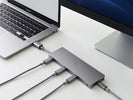
USB-C vs USB 3.0 Hubs in 2025: What’s the Best Choice for Your Laptop?
, by USintpw, 6 min reading time

, by USintpw, 6 min reading time
Choosing the wrong USB hub could slow you down. Find out which is the smarter pick for modern laptops in 2025.
Trying to decide between a USB-C hub and a USB 3.0 hub for your laptop in 2025? Here's the quick answer: If your laptop supports USB-C, a USB-C hub is usually the better choice, offering faster data transfer, higher power delivery, and broader compatibility with modern devices.
But that doesn’t mean USB 3.0 hubs are obsolete. Depending on your setup, especially if you're using older accessories or ports, a USB 3.0 hub might still be the right fit.
In this guide, we’ll compare USB-C vs. USB 3.0 hubs in terms of speed, power, compatibility, and future-proofing. By the end, you’ll know exactly which USB hub to buy for your laptop in 2025.

Before comparing, let’s quickly understand what a USB hub is. A USB hub is a device that expands a single USB port into multiple ports, allowing you to connect multiple devices at once.
For example, if your laptop has only two USB ports, but you need to connect a mouse, keyboard, external hard drive, and a phone charger, a USB hub will let you do that easily.
However, not all USB hubs are the same. Some are USB 3.0 hubs, while others are USB-C hubs, and each has its benefits.
USB 3.0 is an older but still very useful USB standard that was introduced in 2008. It offers faster speeds than USB 2.0 and can transfer data at up to 5 Gbps (gigabits per second).
A USB 3.0 hub usually has USB-A ports (the traditional rectangular USB ports) and can be connected to older laptops, desktops, and gaming consoles.
USB-C is a newer type of USB connector that is small, reversible, and powerful. It can transfer data, charge devices, and even connect to monitors through a single port. Many modern laptops, smartphones, and tablets only have USB-C ports.
A USB-C hub expands one USB-C port into multiple ports, including USB-A, HDMI, SD card slots, and Ethernet.
One of the biggest differences between USB-C hubs and USB 3.0 hubs is speed.
| USB Standard | Max Speed | Common Use Cases |
|---|---|---|
| USB 3.0 | 5 Gbps | Transferring files, and connecting basic accessories like keyboards and mice. |
| USB-C (USB 3.1 Gen 2) | 10 Gbps | Faster file transfers, connecting SSDs and external monitors. |
| USB-C (Thunderbolt 4) | 40 Gbps | High-performance gaming, video editing, and multiple 4K monitors. |
If you just need a hub for basic tasks like using a mouse, keyboard, or flash drive, a USB 3.0 hub is enough. But if you want faster file transfers, external monitors, or laptop charging, a USB-C hub is the better choice.
Another major difference is Power Delivery (PD)
If you need a hub that charges your laptop while connecting multiple accessories, USB-C is the way to go.
If your device only has USB-A ports, a USB 3.0 hub is the right choice.
If your device only has USB-C ports, a USB-C hub is the best option.


In 2025, USB-C hubs will be the best choice for speed, power delivery, and future compatibility. If you have a modern laptop, a USB-C hub will provide the best performance.
However, if you’re using an older device with USB-A ports, a USB 3.0 hub is still a good and affordable option.
When choosing a USB hub, consider your device’s ports, speed needs, and whether you need laptop charging. No matter what you choose, a good hub can make your life much easier!

Subscribe to our emails